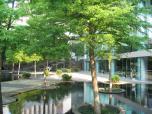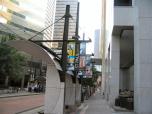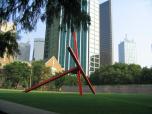




Imagine that you are sitting on a wooden bench with your eyes closed in a grand lofty room. Perfectly arranged music is flowing over you and filling your soul with a sense of wellbeing. You know that when you leave that room you are going to carry this celebration out with you and that it is going to impact you for the remainder of that day and possibly for days to come.
You have just been listening to Mozart’s “Coronation” Mass in C Major, K. 317, a work signifying a new beginning played first for Easter Sunday 1779 in Salzburg cathedral, then for subsequent coronation and other ceremonies in the century to follow. You are at the Cathedral Sanctuario de Guadalupe in Dallas where this piece was performed in November 2011.
This cathedral, like so many other cathedrals and churches, is representative of the highest forms of the arts known to humankind, spanning the spectrum of the music flowing from its organ, the images staring down from its walls and windows, and the life size sculptures inhabiting its sanctuary depicting biblical expressions of the scriptures and teachings that are expounded.
As you walk across the threshold of Cathedral Sanctuario de Guadalupe in Dallas and consider the neighborhood the cathedral is located in, you cannot help but notice that its neighbors represent at least one facet each of what is represented in that church. One is the Dallas Museum of Art which has a section of the museum dedicated to some of the finest European paintings; another, the Meyerson Symphony Hall which plays some of the most beautiful pieces of Bach and Mozart as well as those of other composers; the Nasher Sculpture Garden, which invites people to contemplate the meaning behind a sculpted pose; then both the Wyly Theater and the Winspear opera house which dramatize many classic and contemporary situations in which society finds itself; finally the Booker T Washington School for the Performing Arts, which is teaching students the craft of communicating visually for the benefit of society today and tomorrow. Considering all of these splendid institutions, you are struck by the fact that this church is a vehicle for taking what is fine and classic and offering those things so that all people can touch and experience them. Such is the case with the recent concert, Mozart’s Coronation Mass.
Several things within the cathedral stand apart: one is the sense of warmth you feel when you enter the church; the interior colors of the church are rich while also being tasteful; the stained glass windows depict the usual scenes of Jesus, Mary, the cross, disciples and various saints. As your eyes travel up the height of the church, they view the ceiling which is comprised of various beams going in different directions from the church pointing into the neighborhood. Segmented by each beam are a total of 216 blank panels. What strikes you at this particular moment is the realization that each of these 216 blank panels represents a canvass untouched by the artist’s hand. (I note the cathedral will be undertaking a process to restore an original design to each one of these panels and has already restored one of them.) The combination of the messages preached, the choruses sung, the instrumentation played, the timeless windows, sculpted figurines, and an individual’s response to them, all play their part in the drama that colors those canvasses and reflects the daily life of the church. The many panels on the ceiling tell a story when they are all combined together which is much more than the sum of each one of the 216 of them.
In short, there are many features of the cathedral that invite contemplation and inspire so as to be an impacting force not only upon the other institutions in the Arts District, but throughout society as well. The salient question is this: How have the residents of Dallas, who are not members of this church, treated and viewed and how will they treat and view this facility? Is it just a Catholic church that happens to be a well preserved and restored relic conveniently situated in the Arts District? Or is it also a center where a visitor will seek to come and view the colorful stained glass windows, ponder the message they are conveying, reflect on how he is living today and then be inspired to go forth and impact the city and world? Will he walk past the sculptures along the walls and touch them and consider the feelings evoked by the Scriptural truth that the sculptor was aiming to convey? Will those reliefs cause the visitor to mold a work himself that will serve to outlast his time of wandering upon the earth? Will the masses that he hears serve to stimulate his mind and heart so that he becomes a transformational citizen in the world instead of simply being an object that others can transform? When he listens to a Mozart concert or other production in the grand sanctuary is his spirit stirred within him in a way that elevates his critical thinking and enables him to discern the fine points of modern life?
One of the stained glass windows displays Jesus holding the shepherd’s crook in His right hand and a lamb in His left carried on His shoulder. It displays a message which when taken to heart can become artistic works rising to the ceiling of that cathedral. Many who attend church on a regular basis hear teachings about how they should model their lives to be more like Jesus Christ. If one spends any amount of time looking at this particular window one is struck by how tenderly Jesus is holding the lamb in His left hand. Sheep are meant to be herded, but some manage to slip out from the pen and wander off. When they become lost, it is the job of the shepherd to go and find them and bring them to the fold. It is important to have an expansive heart that seeks to find those who need a community and bring them to a place where they can be fed, not just physically, but spiritually and mentally also. If one studies that window and looks out at the surrounding world and possesses the heart of an artist, he or she can be about creating works, be they businesses, artistic endeavors, social entrepreneurial outreaches or other entities that serve to feed people who are starving or give people drink who are wanting from thirst.
Dallas was privileged to be one of seven cities in the United States to host the traveling exhibition of The Mourners, alabaster figures from the tombs of the Dukes of Burgundy. These figures, each unique in the display of their grief, yet in their totality communicating with one voice, were sculpted during a time of rich artistic endeavor in Dijon, the capital of Burgundy. The fact that these figures still speak so powerfully today, six hundred years later, is testimony to their standing the test of time.
Like the figures in The Mourners, and the semi-permanence of the different aspects of the cathedral, the creation born from the transformation that occurs in the lives of the individuals who deeply interact with the artistic works within this cathedral can be the musical composition that is played at the symphony hall, the crafted sculpture that one marvels about in the garden, the richly stroked and textured painting that one meditates upon at the museum, or the dramatic work performed at the opera house that speaks not only to today but to the future.
Living Works of Art Posted: January 31, 2012 by Chuck DeShazo